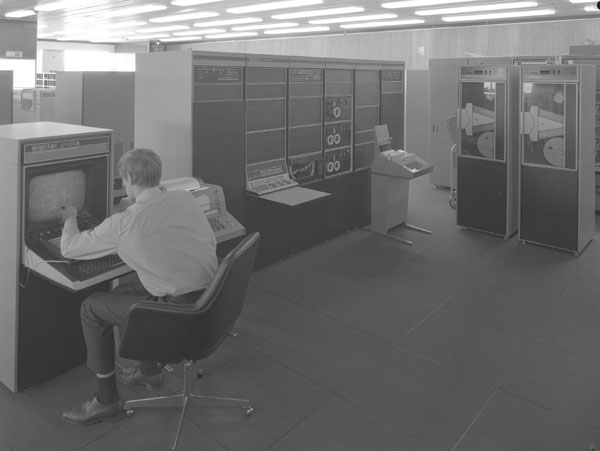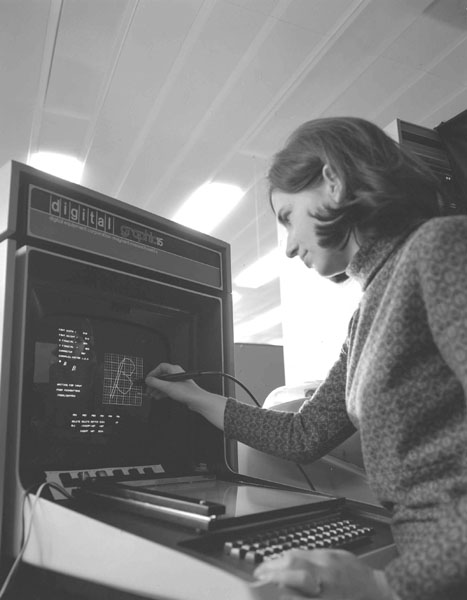

David Toll and Alan Francis joined the Graphics Group in the Autumn of 1971. David Toll spent most of the 1971-72 period getting GROATS transfered to the ICL 1906A. Wade Shaw arrived in 1972 and Eric Thomas replaced Bob Hopgood as head of the Graphics Section. Bob had been promoted was then responsible for the basic software development on the 1906A and the PDP15.

DEC replaced most of the graphics control hardware around September 1971. The display was much more accurate once this had been done. However, the random vector drawing produced significant overshoot if the lines were close to horizontal or vertical. The positioning of short vectors was so inaccurate that a small object was difficult to recognise. Most of the problems came from the deflection yoke of the VT15 Kratos tube which was eventually replaced. It was not until early in 1972 that the VT15 eventually worked satisfactorily.
The Group had been interested in adding computer generated soundtracks to films. Several ways of doing this had been attempted before it was decided to purchase a VCS3 synthesiser and attach it to the PDP15. The VCS3 (Voltage Controlled Synthesiser was a low cost and readily available electronic music synthesiser. It was a stand-alone device that could have its inputs controlled by analogue voltages from a suitable source. A digital to analogue converter was available from DEC but at such a high price that, instead, the necessary modules were purchased and the interface built locally. The cost was originally going to be about £2K but by using cheaper components the price was significantly reduced. The back-plane wiring was done by the Rutherford Laboratory's Electronics Services Department. The PDP15 produced 50 clock pulses per second and the interface was designed so that every parameter of the synthesiser could be changed each time interval and even then would only use about 10% of the PDP15 CPU cycles. The VCS3 eventually arrived near the end of 1972 and it took most of 1973 to get the interface built and working. Bob Hopgood's Hash Films had a sound track added using the synthesiser and were first shown in that form at IFIP'74 in Stockholm.
CASS was the software developed at Atlas to allow the VCS3 synthesiser connected to the PDP15 to be used for generating sound tracks for computer generated films. It was used in the sound track for the Linear Hash film and a number of other films.
The high speed interface between the ICL 1906A and PDP15 was a long drawn out saga. The PDP15 interface was part of the original order but it was not until June 1971 that the hardware was being tested by the two suppliers in their factories. Being a standard interface, the theory was that connecting them together would be a straightforward process.
By the start of 1972, both interfaces were installed and worked perfectly when transferring data back to back on each computer but no exchange of data between computers could be initiated. Neither computer seemed to be able to recognise the signals sent by the other. By April 1972, data could be passed from the 1906A to the PDP15 but not vice versa. A number of minor faults were uncovered in both systems but it was not until 17 April 1972 that John Lawe of ICL gave DEC a specification of the ICL 7203 interface at a joint meeting at the Laboratory to try and work out what the problem was. What immediately became clear was that the polarity of the two interfaces was reversed. It was the one thing that was not precisely defined in the BSI standard! DEC were able to make a quick fix to their interface on the fly and the first transfer between the two machines in both directions happened immediately.
As DEC had only built one interface and ICL six, the DEC engineers (Geoff Fogg and John Walker) changed their interface and on 6 June 1972 a reliable connection between the two machines was established.
The initial speed after taking into account the systems software gave a data throughput of 60 Kbits/sec rather than the 1.2 Mbits/sec that had been hoped for.
Software problems continued to plague the connection for a large part of 1973. New versions of the 1906A operating system inevitably caused new problems to appear including the PDP15 bring down the 1906A which was not too popular. By the end of 1973 a reliable connection was finally established running at around 600 Kbits/sec. Using the interface in earnest with SPROGS on both ends finally happened in the Spring of 1974.
Wade Shaw and Julian Gallop spent most of 1972 working on the PDP15 side of SPROGS which was called PIGS for PDP15 Interactive Graphics. This involved rewriting the basic systems software, VTPRIM, that was supplied by DEC including new drivers for input devices like the stylus and lightpen. The DEC software had assumed a specific way of interacting with devices and the drivers had been developed independently so that there was little in common between the device drivers. As the aim was to allow the user to use the input device of his choice, the need to rewrite all the software was established.
A working basic system was in place by the end of 1972 and was in use by Brian Woodward in an architectural design package. A paper describing the completed system was presented at Interactive Systems.
By 1972, Susan Hockey was using the PDP15 for a series of font designs. The catalogue of the Bodleian Library was being produced electronically and there were books with titles in a variety of languages. Designing fonts for the SC4020 consisted of defining the lines to be drawn by the SC4020. The set of lines needed to produce a good looking character was not easy to judge. In the photo below, several sizes of the glyph being defined are shown to give the designer some idea what the glyph will look like at normal sizes.
